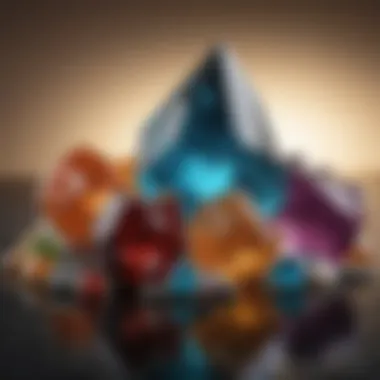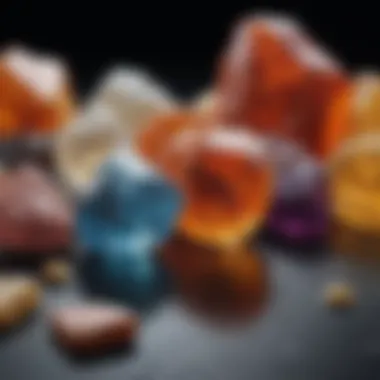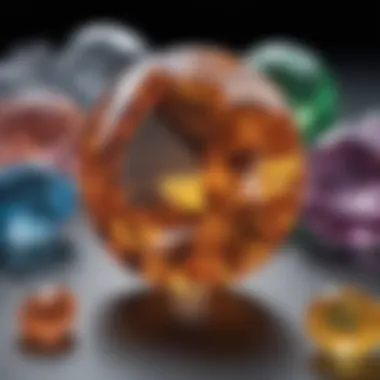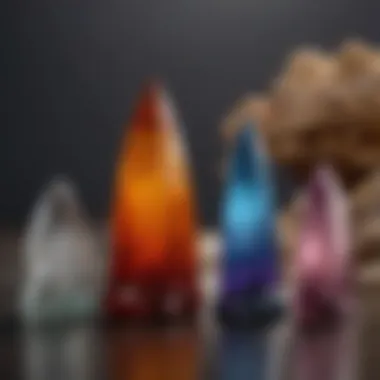Understanding the Mohs Scale of Mineral Hardness


Intro
The Mohs scale is not just about numbers, it’s a window into the world of minerals, revealing their strength and durability. Used widely in mineralogy, it offers a unique framework to understand how different minerals stack up against each other in terms of hardness. The idea behind the Mohs scale is pretty straightforward: each mineral can scratch those that are softer and, conversely, can be scratched by those that are harder. This simple yet effective premise has countless applications, especially in the realms of jewelry making and geology.
In this article, we will take a magnifying glass to the aspects of the Mohs scale. From its inception to its real-world applications, we will parse through the layers of information that give this tool its value. We’ll also touch on various gemstones—an exciting aspect for collectors, enthusiasts, and jewelers alike. But what lies underneath the surface is even more fascinating. So, let’s embark on this journey together, as we scratch the surface of the Mohs scale to uncover its many facets.
Gemstone Overview
Description of the Gemstone
The term 'gemstone' typically refers to minerals that are prized for their beauty, durability, and rarity. However, not all gems are created equal on the Mohs scale. Some, like diamond, sit at the top with a hardness of 10, while others might barely make it on the scale at all. Understanding each gemstone’s position could be the difference between a cherished piece of jewelry and a scratched-up disaster.
Take, for instance, the lovely emerald. Rich green and full of allure, it holds a hardness of 7.5 to 8 on the Mohs scale. Though lovely, it's softer than diamonds and could be prone to scratches if not cared for properly.
It's essential to note that each gemstone carries its unique characteristics:
- Sapphire: Known for its vibrant blue, ranges from 9 on the scale, robust yet elegant.
- Topaz: Varies from 8, loved for its clarity and variety of colors.
- Amethyst: Holds a hardness of 7, making it charming but needing careful handling.
Physical Properties
Each gemstone encompasses specific physical properties that play integral roles in their identification and value.
- Color: It’s the first thing that captures the eye—though the specific hues can vary within a type.
- Clarity: Refers to internal flaws or inclusions. Clearer stones tend to be more valuable.
- Cut: Describes how a stone has been shaped and faceted to enhance its appearance.
- Carat Weight: Measures the size; larger stones can fetch higher prices, all else equal.
Knowing these traits alongside the Mohs hardness rating allows a deeper appreciation of gemstones. Importantly, it helps inform the decisions of jewelry designers to use softer stones within protective settings.
"Each point on the Mohs scale holds not just a number, but a secret about the mineral itself—how it lives, how it shines, and how it withstands the test of time."
Healing Properties
Metaphysical Attributes
For many, gemstones go beyond aesthetics; they delve into the realm of holistic healing. Metaphysically speaking, various stones are believed to possess unique attributes that can affect one's emotional and physical well-being. For example:
- Rose Quartz: Often associated with love and compassion, this soft pink stone encourages harmony.
- Lapis Lazuli: Said to enhance communication and self-awareness, it’s revered for its deep blue hue.
- Citrine: Known as the stone of abundance, it fosters creativity and brings prosperity.
Common Uses in Holistic Practices
In the world of holistic practices, gemstones are used in multiple ways:
- Meditation: Many practitioners use specific stones placed on the body or held during meditation sessions to enhance energy flow.
- Jewelry: Wearing certain gemstones is believed to transfer their healing properties to the wearer.
- Environment: Crystals may be placed in homes or workspaces to promote specific energies, such as calm or focus.
Understanding both the emotional and physical properties of gemstones allows enthusiasts to make more informed choices. With knowledge comes better appreciation, making the journey through the world of gemstones all the more enriching.
Preface to Mohs
When venturing into the realm of minerals and gemstones, one cannot overlook the significance of Mohs. This topic serves as a foundation for understanding hardness, an essential characteristic that plays a pivotal role in various applications—from geology to jewelry making. Through this section, we’ll navigate the key concepts surrounding Mohs, laying out not just definitions but also origins and implications in mineralogy. Delving into this subject helps solidify the practical knowledge necessary for enthusiasts, collectors, and professionals alike who wish to understand the strength and beauty of these natural wonders.
The Definition of Mohs
At its core, the Mohs scale measures the hardness of minerals based on their scratch resistance. Developed by the German geologist Friedrich Mohs in 1812, it ranks ten minerals from talc, the softest, to diamond, the hardest. Each mineral can scratch those below it on the scale, thus establishing a relative framework. It's simple yet fundamentally robust—a way for even the casual observer to compare different minerals at a glance.
So, when someone mentions that quartz (ranked 7) can scratch glass but cannot be scratched by topaz (ranked 8), they are tapping into a practical dialogue informed by the Mohs scale.
Origins of the Mohs Scale
The Mohs scale was birthed out of necessity during a time when understanding mineral properties was crucial for advancements in various sciences and industries. Friedrich Mohs designed this scale with a straightforward approach; he wanted a way to convey hardness that would be relatable and accessible to geologists and mineralogists of all backgrounds. His selection of ten minerals was not arbitrary; each mineral presented distinct properties that made them ideal for this scale. For instance, talc, with its soft, slippery feel, contrasts starkly with the toughness of diamond. This duality of experiences provides clear, tangible benchmarks for comparison.


Significance in Mineralogy
In mineralogy, the Mohs hardness scale holds paramount importance. It influences everything—from how we classify minerals to their practical applications in various sectors. For jewelers, understanding a gemstone's hardness aids in determining its wearability and suitability for different jewelry designs. For geologists, hardness testing can unveil a wealth of information about a mineral's origins and the environment in which it formed.
"Mohs hardness is not just a number; it encapsulates the mineral’s story, its resilience, and its ability to endure the test of time."
In sum, the introduction of Mohs and its related concepts equips individuals with essential insights into the composition and characteristics of minerals. This groundwork is invaluable for anyone keen on delving deeper into the fascinating world of gemstones and geology.
The Mohs Hardness Scale Explained
The Mohs hardness scale stands as a fundamental measurement tool in the field of mineralogy, holding pivotal importance for collectors, gem enthusiasts, and professionals in geology and jewelry design alike. Understanding this scale offers insights into the physical properties of minerals, which can be incredibly beneficial from both an educational and a practical perspective. This section delves into the details of this scale, unveiling its structure and methodology, as well as providing a clearer picture of hardness measurement in minerals.
Structure of the Scale
At its core, the Mohs hardness scale is a simple ranking system that categorizes minerals based on their ability to scratch one another. First introduced by Friedrich Mohs in 1812, this scale employs a sequence of ten minerals, each assigned a numerical value, ranging from 1 (softest) to 10 (hardest). The minerals in this lineup represent a variety of physical and chemical properties, showcasing a broad spectrum of hardness. The scale includes:
- Talc (1) - Notoriously soft, talc can be easily scratched with a fingernail.
- Gypsum (2) - Slightly harder than talc but still soft enough to be scratched by a fingernail.
- Calcite (3) - Recognizable for its ability to create effervescence when exposed to acid.
- Fluorite (4) - Known for its myriad colors and is often found in the form of octahedral crystals.
- Apatite (5) - This mineral is crucial in the production of fertilizers and famous for its varied colors.
- Orthoclase Feldspar (6) - A common member in igneous rocks, orthoclase exhibits a shiny surface when polished.
- Quartz (7) - A familiar mineral in many environments, quartz comes in numerous varieties and is highly valued in jewelry.
- Topaz (8) - Known for its range of colors and crystal forms, particularly popular in gemstones.
- Corundum (9) - Comprising sapphires and rubies, corundum showcases its durable nature.
- Diamond (10) - Often heralded as the hardest natural substance known to humankind.
This clear, ordered structure allows users to understand not only the relative hardness of these minerals but also facilitates their identification based on physical characteristics.
How Hardness is Measured
The process of measuring hardness via the Mohs scale is both intuitive and practical, relying primarily on scratch tests. To determine a mineral's hardness, one simply attempts to scratch it with another mineral of known hardness. If the mineral in question can be scratched by the reference mineral, it is classified as softer; if it scratches the reference mineral, it's classified as harder. This straightforward method underscores the hands-on nature of mineralogy.
For instance, if a piece of fluorite is scratched by a sample of quartz, it confirms that fluorite is indeed softer than quartz, corresponding with their respective placements on the scale. It's worth noting that the scale operates essentially on a relative basis rather than offering precise quantitative values, providing a qualitative view of hardness instead.
"The Mohs scale serves as a practical reference for those engaged in gemstone evaluation and mineral identification, guiding decisions that encompass various uses across industries."
Finale
The structure and measurement methods of the Mohs hardness scale form the backbone of how we understand and classify minerals. This understanding not only aids in the study and appreciation of geology but also enhances the fields of jewelry design and mineral collection. By grasping the principles behind this scale, enthusiasts and professionals alike can deepen their knowledge and appreciation for the intricate world of minerals.
The Minerals on the Mohs Scale
The Mohs scale serves as a cornerstone in mineralogy, a true touchstone for anyone who’s interested in understanding hardness and scratch resistance. Why is it so important, you may ask? Well, the minerals listed are not just random examples; they showcase a vast range of properties that help illustrate the concept of hardness in an accessible way. They transcend basic definitions and take us into the realm of comparison, practical applications, and distinct features that set each mineral apart. For gemstone enthusiasts, collectors, and even designers, knowing the properties of these minerals is not merely a point of interest but a fundamental aspect that underpins many decisions, whether in acquisitions or applications.
Talc to Diamond: An Overview
Starting with Talc, which holds the honor of being the softest mineral on the Mohs scale, it is often the starting point for discussions about hardness. With a value of 1, talc is easily scratched by anything harder. In contrast, Diamond, sitting high at a 10, is not just the hardest mineral; it is a symbol of durability and luxury. This stark contrast sets the stage for understanding the framework of the Mohs scale.
To give a clearer picture, here’s a quick rundown of some minerals on the scale, listed with their hardness values:
- Talc (1): Very soft, soapy feel.
- Gypsum (2): Can be scratched with a fingernail.
- Calcite (3): Reacts with dilute hydrochloric acid.
- Fluorite (4): Displays fluorescence and comes in diverse colors.
- Apatite (5): Commonly found in teeth and bones.
- Orthoclase (Feldspar) (6): Critical in ceramics and pottery.
- Quartz (7): Durable and a favorite in both jewelry and construction.
- Topaz (8): Known for its range of hues, often used in jewelry.
- Corundum (9): Includes rubies and sapphires, valued gemstones.
- Diamond (10): Renowned for its unmatched hardness.
This overview not only provides clarity on specific minerals but also sets the stage for deeper exploration.
Unique Features of Each Mineral
Delving into specifics, each mineral on the Mohs scale tells a tale unique to its composition and application. For instance, talc is noted for its softness and is often used in talcum powder. In contrast, quartz, ranked at 7, is exceptionally hard and has myriad uses, from watches to countertops, due to its resilient nature.
- Gypsum: Beyond its low position, it is essential for drywall and plaster.
- Fluorite: Notable for its ability to change color under varying light conditions.
- Topaz: Available in a rainbow of colors, making it a go-to for gem collectors.
- Corundum: This offers the beautiful ruby and sapphire, both popular in high-end jewelry.
“Each mineral on the Mohs scale plays a vital role in our understanding of hardness, illustrating its practical significance in the natural world.”
Practical Implications for Jewelry and Gemstones
Understanding the Mohs scale is not merely academic; it has profound practical implications, especially in the realm of jewelry and gemstone appraisal. For instance, the hardness of a mineral often dictates its suitability for everyday wear in pieces like rings, which are subject to daily abrasive forces.
- A gem like diamond can withstand scratches from virtually any material and is therefore the preferred choice for engagement rings.
- On the other hand, talc, being soft, would be inappropriate for any jewelry that experiences wear and tear.
- Additionally, recognizing the hardness allows for informed decisions in cutting and polishing techniques, crucial for achieving that sparkling finish many desire.


Applications of the Mohs Scale
The Mohs scale isn't just an academic exercise; it has real-world implications that resonate through various sectors. Understanding its applications opens doors to recognizing the practical significance of mineral hardness in our daily lives. This section peels back the layers to reveal how a simple scale not only draws lines between minerals but also creates foundational ripples in industry, research, and even jewelry design.
Industrial Use of Hardness Testing
In industries that utilize minerals, knowing the hardness can save both time and resources. The Mohs hardness scale serves as a quick-reference chart for evaluating the materials encountered daily. For instance, in the manufacture of industrial tools, selecting the right hardness can be akin to picking the proper recipe ingredient: choose the wrong one, and the outcome might not just be substandard—it could be detrimental.
- Tool manufacturing: Companies specializing in cutting tools often use the Mohs scale to assess the durability of their products. A carbide tool rated 9 on the Mohs scale can withstand wear much longer compared to those rated lower.
- Construction materials: Architects and builders benefit from understanding mineral hardness when selecting materials for durability. For example, granite, which ranks around 6 to 7, is often favored for countertops due to its resistance to scratching.
- Manufacturing processes: Industries involved in grinding or drilling frequently rely on hardness ratings to inform their processes. Knowing which minerals can cause wear to machinery parts can help avoid costly repairs and downtime.
Testing hardness in an industrial context isn't just a routine check; it's often a strategic choice that determines a project's success.
Geological Surveys and Research
For geologists, the Mohs scale is not just a tool; it’s a lens through which they analyze Earth's composition. When conducting surveys, geologists often determine rock hardness as a first step in assessing more intricate geological features.
- Resource exploration: In the hunt for minerals and ores, hardness can indicate where valuable resources may lie. A quick scratch test can, in some cases, guide further exploratory efforts.
- Mapping geological formations: Hardness provides clues about the history and composition of geological formations. Different minerals, with their distinct hardness levels, help geologists build accurate maps and understand the processes that formed them.
- Educational frameworks: Beyond practical applications, the Mohs scale is a cornerstone in teaching geology. Students gain insights into how minerals can be identified and classified based on hardness, making it essential in academia.
The scale’s role in geology supports not just industry needs but also frames our understanding of the planet itself, leading to educated guesses about what lies beneath the surface.
Gemstone Evaluation and Appraisal
When it comes to gemstones, the Mohs scale morphs into something even more crucial: a guideline for collectors, appraisers, and jewelers alike. Knowing the hardness of a gemstone isn’t merely trivia; it’s vital for maintaining the integrity and beauty of the piece.
- Consumer confidence: For buyers, aware of the Mohs scale helps in making informed decisions. A sapphire rated 9 is a more suitable choice for everyday wear compared to a softer stone like malachite, which ranks a mere 3.
- Appraisal effectiveness: Evaluators often use hardness as a factor alongside other parameters, such as clarity and color. This holistic understanding generates more accurate appraisals, affecting value assessments for both insurance and resale.
- Design implications: Jewelry designers consider hardness when crafting pieces. A ring meant for daily wear should feature stones that stand up to scratches and other wear, while a certain elegance can also be achieved in softer stones that won’t see as much exposure.
In the world of gemstones, the Mohs scale acts as an unsung hero. It acts as a guide through the sandstorms of considerations surrounding value, longevity, and aesthetic beauty.
"The Mohs scale, while simple, can have profound implications across various fields—it's not merely about rocks, but a key to understanding our material world."
With various applications spanning multiple domains, the Mohs hardness scale proves pivotal. Its significance in industry, research, and gemstones cannot be overstated; rather, it reads like a chapter in an intricate story about the materials that build our world.
Misconceptions Regarding Mohs
Understanding the Mohs hardness scale is crucial for both amateurs and professionals in the fields of geology and gemology. Unfortunately, misconceptions often cloud its true purpose and functionality. These misunderstandings can lead individuals astray when assessing minerals’ qualities, especially among gemstone enthusiasts. By clearing up confusion regarding the Mohs scale, readers can better appreciate its significance and utility.
Common Errors in Understanding Hardness
One major error people often make is equating hardness with durability. It’s a common belief that a harder mineral always translates to a more durable one. However, that’s just not the case. For instance, diamond, rated a 10 on the Mohs scale, is indeed the hardest natural material known but can shatter under a significant impact—think of hitting it with a hammer. On the flip side, feldspar, with a rating of 6, can withstand wear and tear better because of its structure.
Another misunderstanding revolves around the scale’s linear interpretation. Many folks believe that the differences in hardness between minerals is uniform. In reality, the scale is not logarithmic. For example, the difference between a rating of 5 (apatite) and 6 (feldspar) is not the same as the difference between 6 and 7 (quartz). Each increase in the degree of hardness isn't simply one step higher; it can represent a quite variable increase in resistance to scratching.
- People sometimes use hardness to gauge a mineral’s overall value, mistaking high hardness for a higher market price. This observation is particularly misleading in the world of gemstones. A softer stone, like opal, may hold more value due to its rarity, despite having a lower hardness rating compared to ruby.
Limitations of the Mohs Scale
While the Mohs hardness scale is an indispensable tool in mineralogy, it’s not without its limitations. One significant constraint is that the scale only measures scratch resistance. It doesn’t account for other important attributes of minerals, such as toughness, cleavage, or fracture. These properties can substantially dictate how a mineral behaves under varying conditions.
Additionally, the scale lacks granularity; it simply doesn’t provide enough detail for precise applications. Suppose you're assessing materials for industrial use. The Mohs scale might suggest that both quartz and topaz are suitable based on their hardness, yet other characteristics may render one far more appropriate than the other.
"The hardness scale is like comparing apples to oranges; both are fruits, but their uses and characteristics differ significantly."
Moreover, the Mohs scale is inherently subjective. Testing involves scratching one mineral against another to determine its hardness, which introduces variability. Anyone who has tried scratching a teddy bear with their nails can tell you it’s tricky to gauge just how hard or soft something is. Variations in testing technique or environmental factors often muddy the waters.
In summary, dispelling common misconceptions and acknowledging the limitations of the Mohs scale allows for a better understanding of its true utility. Clarity is key when navigating the fascinating world of minerals and gemstones. By keeping these points in mind, jewelry designers, collectors, and enthusiasts can arm themselves with knowledge that enhances both appreciation and application.
Comparing the Mohs Scale to Other Hardness Scales
The Mohs scale serves as a foundational tool for assessing mineral hardness, but it exists within a broader context of hardness measurement techniques. Understanding how the Mohs scale compares to other methods—such as the Knoop and Vickers hardness tests—illuminates the merits and costs associated with each approach. Such knowledge is invaluable for gemstone enthusiasts and professionals alike, as it informs their choices when identifying and appraising minerals.


Knoop Hardness Test
The Knoop hardness test is noteworthy for its precision. This method employs a diamond indenter shaped like a rhombus, making it suitable for fragile materials or thin films. An advantage of the Knoop test is its ability to measure hardness on a micro-level, which is particularly useful when dealing with gemstones that require delicacy. Unlike the Mohs scale, which provides a qualitative ranking, the Knoop test yields quantitative results, producing a single hardness number.
To conduct this test, a small load is applied to the diamond, making a distinct indentation that can be measured microscopically. These results lend themselves well to industries where even minor hardness variations have significant implications, such as in electronics or fine jewelry. That’s where it shines!
Some key elements of the Knoop hardness test include:
- Scratch Resistance: Its measurement relates to how resistant a material is to scratches, just like Mohs but more precisely.
- Microhardness: It gives readings on a microscopic scale, allowing for more detailed assessments.
- Versatility: Often applied to rare stones and coatings, highlighting fine differences that might influence value.
Vickers Hardness Test
The Vickers hardness test adds another layer of complexity to hardness measurement. Similar to the Knoop test, it utilizes a diamond indenter; however, this one is a square pyramidal shape. The Vickers test provides a broader applicability than Mohs, as it measures hardness in both macro and micro contexts. Its versatility is one of its most appealing features, allowing it to assess diverse materials from precious stones to industrial metals.
In the Vickers test, a specific force is exerted on the sample, creating an impression. The length of the diagonal of the indentation is measured to calculate hardness. This technique provides valuable quantitative data, often expressed in Vickers hardness numbers (HV).
Some highlights of the Vickers hardness test are:
- Widespread Application: It can be used for a broad range of materials, from minerals to metals.
- Accuracy: Offers precise measurements, making it a preferred choice in engineering applications.
- Depth of Measurement: Useful for assessing coatings or small samples, similar to the advantages found in Knoop testing.
"Each hardness test serves a unique purpose, yet they all complement each other in the pursuit of understanding material properties."
Educational Resources and Tools for Understanding Mohs
Having a grasp on the Mohs scale and its implications in mineralogy is crucial for anyone genuinely interested in gemstones or the science of geology. But without the right resources, one might find themselves swimming upstream, only grasping the surface of this fascinating topic. This section highlights essential educational materials and tools that can deepen your understanding of the Mohs scale, making you better equipped to appreciate its relevance and practical application.
Books and Publications
Diving into books is one of the most traditional yet effective ways to learn about the Mohs scale. Well-researched literature presents in-depth discussions, historical contexts, and practical implications you might not find elsewhere. For instance:
- "Mineralogy: An Introduction to the Study of Minerals and Crystals" by George H. Bodner – This book offers a thorough introduction to mineral properties with a dedicated focus on hardness scales.
- "The Gemstone Identification Manual" by Anthony D. P. Thieme – Not only a guide for identifying gemstones, but this book also explains the hardness aspect and why it matters for collectors.
These types of publications often include illustrations that showcase minerals and their textures, making concepts more tangible and easier to digest. Reading these books provides a solid background—not just on Mohs but also on the larger landscape of mineralogy.
Online Platforms and Communities
The digital age offers a bounty of resources, from in-depth websites to engaging online communities. Websites like Britannica and Wikipedia serve as excellent starting points to get quick facts and detailed information. They often have links to studies or articles, which can lead you deeper down the rabbit hole of mineral science.
One cannot overlook the value of communities found on platforms like Reddit and Facebook where enthusiasts share their findings and experiences. Joining such groups allows you to ask questions, share insights, and learn from others’ mistakes and successes. Here you can:
- Discuss practical applications of the Mohs scale in jewelry making or geology.
- Exchange tips for identifying minerals based on hardness.
- Speak with professional gemologists to gain firsthand knowledge.
Engaging in these communities can broaden your perspective and help you gain practical knowledge that textbooks alone may not provide.
By utilizing a mix of traditional literature and modern digital resources, you can cultivate a holistic understanding of the Mohs scale. Whether you’re a collector eager to evaluate your stones or a student diving into geology, these educational tools will equip you with the knowledge to navigate the intricacies of mineral hardness with confidence.
Ending
The conclusion acts as the final piece in the puzzle of understanding the Mohs scale. By summarizing the most crucial aspects covered throughout the article, it helps reinforce the significance of this scale not only in mineralogy but also in various practical applications. The Mohs hardness scale serves as a guidepost for professionals and enthusiasts alike, impacting decisions in fields as varied as jewelry design, geology, and material science.
Summation of Key Points
In recapping the key points from this article, it is essential to highlight several elements:
- Origins and Development: The scale, created by Friedrich Mohs in 1812, has maintained its relevance despite the emergence of more intricate hardness testing methods.
- Simple Yet Effective: The scale’s simplicity makes it accessible for both novices and experts, allowing for quick and straightforward assessments of a mineral’s hardness.
- Practical Applications: Its usefulness spans industrial uses, geological surveys, and gemstone evaluations, making it a cornerstone tool in multiple fields.
- Common Misconceptions: It's imperative to understand the limitations and common errors associated with the scale to avoid misinterpretation.
- Future Directions: With advancements in technology and new methodologies for hardness testing, the relevance of the Mohs scale remains pertinent as the field evolves.
Overall, the Mohs hardness scale is more than just a system; it embodies a historical journey through mineral exploration and understanding, providing a foundation that many other methods build upon.
The Future of Hardness Testing
As we look ahead, the future of hardness testing holds great promise. While the Mohs scale remains a staple in the field, emerging technologies are continuously reshaping how we evaluate materials. One exciting direction involves the integration of digital tools into hardness testing, allowing for precision and enhanced accuracy.
- Innovative Methods: New approaches like nanoindentation offer insights that are far more detailed than traditional scales could provide. This method can assess hardness at microscopic levels, which is valuable for advanced material science.
- Cross-Disciplinary Applications: As interest grows across different sectors—healthcare, engineering, and consumer goods—the importance of reliable hardness testing becomes increasingly apparent.
- Education and Outreach: With educational platforms readily available online, reaching a broader audience is achievable, fostering a new generation of mineralogists and gemstone enthusiasts who understand the values underpinning hardness testing.
In this dynamic landscape, advancements in these areas will only deepen our grasp of material properties, further enhancing the significance of Mohs and complementing it with innovative alternatives. The ongoing evolution opens new doors for exploration, leaving us curious as to where this journey will lead the mineralogy community next.







